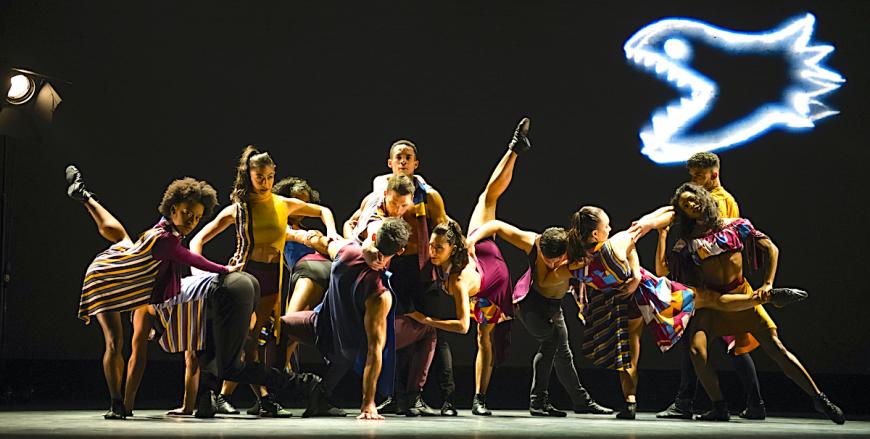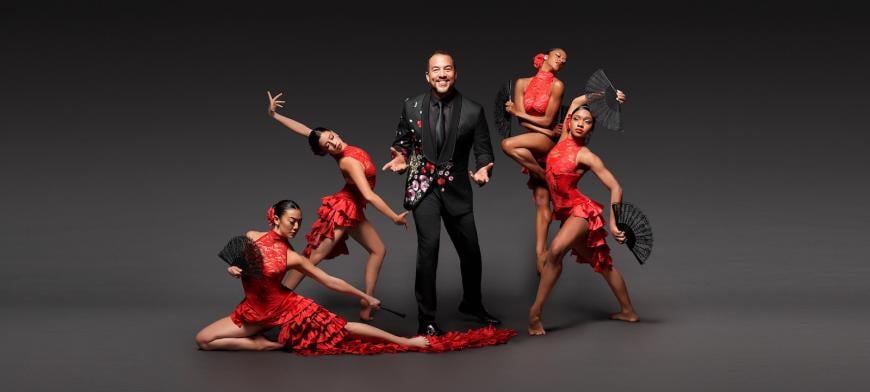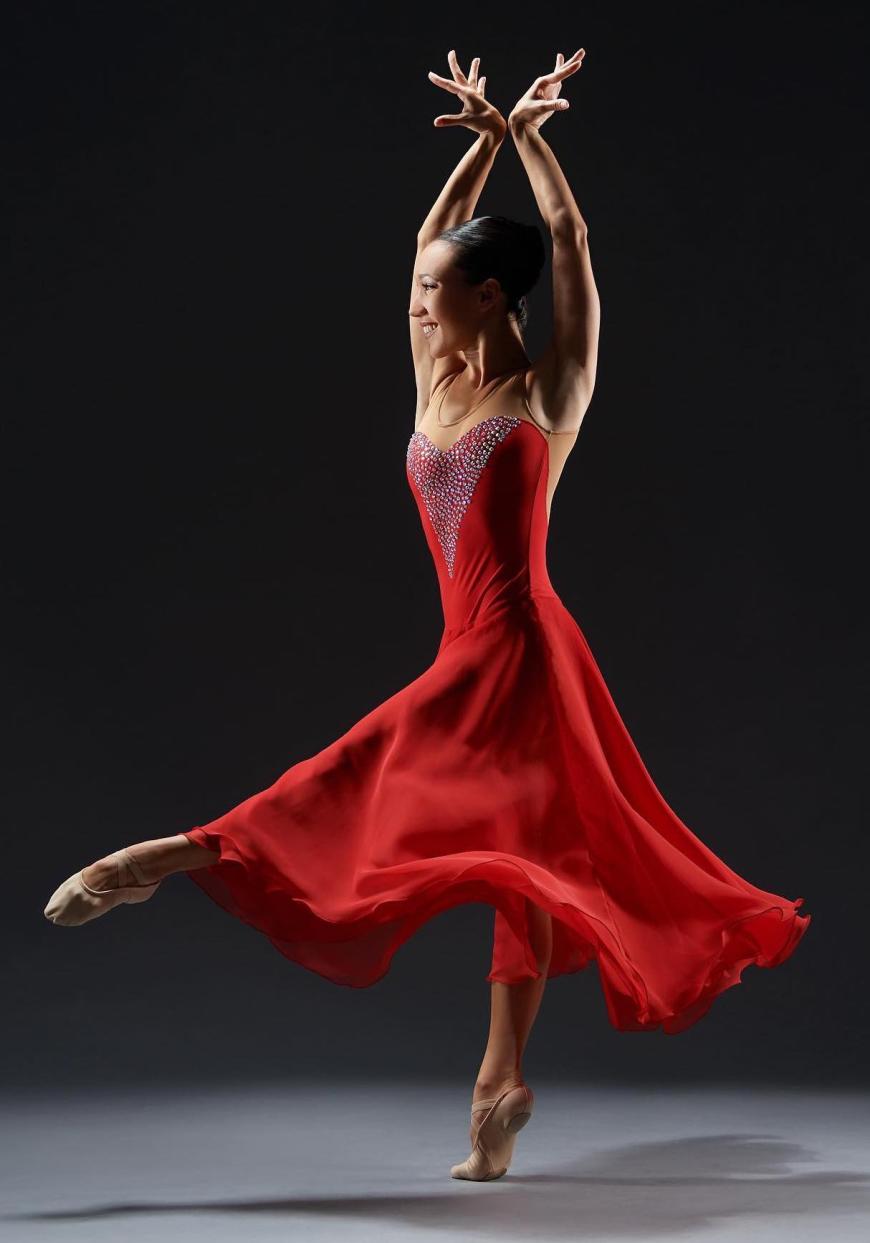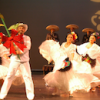
Ballet Hispánico’s first-ever visit to Cal Performances Saturday night was — amazingly — themed around its 50th anniversary. Its "Noche de Oro" program tapped three streams of Latinx culture. In all, it offered an entertaining, virtuosic picture of the many influences impacting the company’s journey, an itinerary demanding thoughtful exploration and getting it in spades.
The New York-based troupe founded by Tina Ramirez, led now by Eduardo Vilaro, brought 16 dancers on this western tour (one is stuck in Brazil, a consequence of pandemic events). After 18 months of shutdown, its vibrance and unity is a wonder to behold. The audience, too, was pretty wonderful — masked, checked for COVID-19 status, and applauding warmly. To an onlooker, this first live show since, oh, March 2020 was a study in paradox. For months, we’ve been watching videos of dancers turned loose, of necessity, outdoors. And although those explorations of new territories brought their professional chops, their passions, to the fore, Ballet Hispánico’s dancing, within the confines of the Zellerbach Hall, felt remarkably open — free, spacious, the picture of courage and generosity.

Artistic Director Vilaro, a Cuban-born dancer and teacher in the company from 1988 to 1996, spent 10 years as the founder and director of Luna Negra Dance Theater in Chicago. He has himself made 40 ballets, but he brought none, choosing instead works by Vicente Nebrada, Annabelle Lopez Ochoa, and Gustavo Ramírez Sansano as exemplars of the troupe’s history and growth.

The evening began near the beginning, with Nebrada’s Arabesque, a dual play on ballet’s upraised leg and the graceful upward flourishes that are a theme of Moorish architecture and decor, beautifully exemplified in the ages-old mosques of Cordoba, Spain. Created for the company in 1984 and set to Enrique Granados’s 12 Spanish Dances, on piano, Arabesque premiered at a time when the company was experimenting with extending the reach of classical ballet to embrace flamenco, and, as seamlessly depicted here, vice versa. in solos, duos and ensembles, the dancers, the women in pastel chiffon gowns (except for Laura Lopez, in the leading role, who wore red), the men in spangled black, captured the essence of flamenco’s duende, or soul. Lopez set the tone with her remarkably elegant, flexible arms, her supple back, and her precise footwork.
As the dancers moved, they seemed to trace the flourishes of curving arabesques with their arms, no matter the tempo or the nature of the particular dance in the suite. Even in the most vivacious moments, as the men of the company soared in balletic leaps augmented with Latin daring, legs flexing or kicking, the aura of grace under the pressures of speed and altitude held sway. Nebrada’s choreography for the 10 men and women combined timeless elegance and gentility with plenty of time in the air, plus a steady undercurrent of fiery warmth.
Tapping another vein of Latinx life entirely, ace choreographer Annabelle Lopez Ochoa’s argument with mainland culture’s mono-dimensional depiction of Puerto Rican emigres, the 2019 Tiburones, or Sharks, satirized the movie West Side Story’s vision of the New York community’s young men and women as hot-blooded machismo guys and subservient, girly chicks, particularly by showcasing the fateful dance at the gym where Tony meets Maria. Ochoa’s rage at how non-Puerto Ricans got to decide on and define the culture for a mass audience in an Oscar-winning phenomenon leads to hilarious ensemble payback. For one thing, the men arrive onstage in stiletto heels, and clearly enjoy wearing them. Next, the signature move of Tony and Maria’s fateful meeting, with director and choreographer Jerome Robbins’s little finger snaps and hip shifts, are performed by two men. The women don’t feel pretty, they feel virago, ending their frantic mambo by stabbing the male director (who keeps clacking his slate together like a whip) to the floor with the stilettos, and capping the whole event with a stiletto barrage from the wings. Ochoa simultaneously struck an angry nerve and a funny bone, bringing the audience, cheering, to its feet. It wouldn’t have worked without her spectacular, sharply observational choreography, somewhat echoing, yet methodically contradicting the film’s impact. Ochoa’s takedown ballet is a tour de force. And farce.
In 2012, Spanish choreographer Gustavo Ramírez Sansano created 18+1, marking his 19th year as a dancemaker. It’s delightful, set to the music of Cuban bandleader Pérez Prado, whose compositions and arrangements popularized the mambo in the 1950s. Aside from avidly listening to Prado on the radio as a kid, it reminded me of summer vacation at a New Hampshire resort, where a Cuban combo played many of the songs in the ballet, and practicing the mambo and the cha-cha beside the lake with my mom.
The great news is that nostalgia isn’t necessarily what it used to be. Sansano’s choreography has a distinct, ageless, and edgy charm. The dancers are jaunty, and just a little weird, in their precisely arrayed platoons. They wear marvelous unisex gray tunic outfits, highlighted by black socks and an occasional flash of red, becoming a sweet solo step-out for Shelby Colona, sporting an entire red shirt. The well-disciplined in their parades and rows give way to a butt jut, a cluster of antic moves and a vaudeville-style mirror dance, one dancer echoing another. Eventually, the dancers make their way to the edge of the stage, sitting close together, dangling their feet and forming a kickline. Who knew a kickline could include arm kicks? Ballet Hispánico knew. It would be lovely to see them here more than every 50 years.




